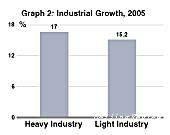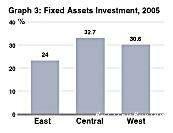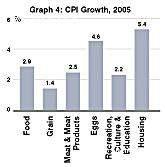State of the Market

National Economy
In 2005, the Chinese economy showed a strong momentum of growth, improved efficiency, a mild rise of prices and enhanced vitality, said the National Bureau of Statistics.
GDP. According to preliminary estimation, the gross domestic product (GDP) for 2005 totaled 18.23 trillion yuan, up 9.9 percent in terms of comparable prices, a bit lower than the 10.1-percent growth in the previous year (see graph 1). Of this total, the added value of the primary industry, secondary industry and tertiary industry stood at 2.27 trillion yuan, 8.62 trillion yuan and 7.34 trillion yuan, growing 5.2 percent, 11.4 percent and 9.6 percent, respectively, year on year.
Agriculture. In 2005, the total output of grain arrived at 484 billion kg, 3.1 percent or 14.6 billion kg more than in 2004. Output of cotton reached 5.7 million tons, a decline of 9.8 percent from the previous year. The output of oil-bearing and sugar crops remained the same as a year ago. Despite bird flu outbreaks, growth was still seen in the animal and husbandry industry, with the output of meat climbing 6.3 percent over the previous year.
Industrial Growth. Throughout the year, the added value of all industrial sectors was 7.62 trillion yuan, a year-on-year increase of 11.4 percent. All state-owned enterprises as well as non-state enterprises with annual sales revenue over 5 million yuan (enterprises above designated size) completed an added value of 6.64 trillion yuan, growing 16.4 percent year on year, 0.3 percentage points lower than the rate of 2004. Of the total, added value completed by state-owned and state holding enterprises grew 10.7 percent. In December alone, the added value completed by enterprises above designated size stood at 671.2 billion yuan, increasing 16.5 percent over the previous year (see graph 2). The sales ratio stood at 98.1 percent in industrial enterprises above the designated size. During 2005, the profits made by those enterprises expanded 22.6 percent to 1.44 trillion yuan.

Fixed Assets Investment. In 2005, fixed assets investment totaled 8.86 trillion yuan, increasing 25.7 percent from a year ago, 0.9 percentage points lower than the rate of 2004 (see graph 3). Of this total, fixed assets investment in urban areas reached 7.51 trillion yuan, expanding 27.2 percent year on year. In December alone, 1.18 trillion yuan was invested in the urban areas, growing 24.2 percent year on year. Last year, investment in rural areas increased 18 percent. Improvement was achieved in the structure of investment in different sectors. The investment in smelting and pressing of ferrous metals was up 27.5 percent and that in manufacturing of non-metal products gained 26.6 percent, 0.1 percentage point and 15.1 percentage points lower than those in the previous year.
Retail Sales. In 2005, total retail sales of consumer goods reached 6.72 trillion yuan, up 12.9 percent year on year. The real growth rate stood at 12 percent after allowing for price fluctuations, 1.8 percentage points higher than in the previous year. In December alone, retail sales of consumer goods went up 12.5 percent to 685 billion yuan. Of the total, retail sales of consumer goods in urban areas increased 13.6 percent and those in rural areas were up 11.5 percent. The growth of the wholesale and retail sector reached 12.6 percent and that of catering sector was 17.7 percent. Sales of communication equipment were up 19.9 percent, and those of household electric appliances and audio-video appliances increased 14.8 percent. Retail sales of automobiles as well as oil and oil products grew 16.6 percent and 34.4 percent, respectively, year on year.

Price. In 2005, the consumer price index (CPI) was up 1.8 percent year on year, 2.1 percentage points lower than the rate of 2004 (see graph 4). In December, the index rose 1.6 percent over a year ago. Of the total, CPI climbed 1.6 percent in urban areas and 2.2 percent in rural areas. Retail prices of commodities inched up 0.8 percent for the whole year and were up 0.9 percent in December.
Purchasing prices of raw materials, fuel and power grew 8.3 percent in 2005 and climbed 5 percent in December alone. Producer prices of manufactured goods increased 4.9 percent throughout the year and were up 3.2 percent in December. Prices of fixed assets investments rose 1.6 percent. Housing prices in 70 large and medium-sized cities increased 7.6 percent.
Income of Urban and Rural Households. In 2005, the per-capita disposable income of urban households reached 10,493 yuan, a real growth of 9.6 percent after allowing for price fluctuations, 1.9 percentage points higher than that in the previous year. The per-capita net income of rural households arrived at 3,255 yuan, a real growth of 6.2 percent, 0.6 percentage points lower than the rate in 2004. By the end of 2005, the savings deposits of households amounted to 14.1 trillion yuan, an increase of 2.1 trillion yuan compared with that at the beginning of the year. The registered urban unemployment rate stood at 4.2 percent by the end of 2005, maintaining the same level as in the previous year.
The above figures show that the national economic situation was fairly good in 2005. In particular, the stability of economic performance was strengthened to some extent, and progress was seen in a more balanced development. All these have led to the consummation of the first five-year plan of economic and social development in this century, and laid a solid foundation for the stable and fast growth of the economy in the new year as well as the 11th five-year plan period. Key problems existing in current economic performance are: weak agricultural base, insufficient staying power for grain production and an increase of rural household income, excess investment in fixed assets with irrational structure and the extensive mode of economic growth.

Trade of Pharmaceuticals
Chinas imports and exports of pharmaceuticals amounted to $25.64 billion in 2005, according to the Ministry of Commerce. Of the total, imports were $11.84 billion, up 18.5 percent, and exports were $13.8 billion, up 28.1 percent.
In the exports of pharmaceuticals, exports of Western medicine amounted to $12.97 billion, including raw materials, ready-made medicine, bio-medicine, medical appliances and surgical dressings, accounting for 94 percent of the total exports. Raw materials of Western medicine were also the biggest exports and amounted to $7.9 billion, accounting for 57.3 percent of the total. Exports of medical appliances reached $3.68 billion, accounting for 26.7 percent of the total. Exports of bio-medicine increased most rapidly, up 50.85 percent to $480 million. Exports of ready-made medicine were $380 million, up 22.3 percent, and those of surgical dressings reached $530 million, growing 19.5 percent year on year.
Exports of traditional Chinese medicine totaled $830 million, including raw materials and ready-made medicine and extract, accounting for 6 percent of the total exports of pharmaceuticals. Exports of Chinese medicine extract increased 31.2 percent to $290 million, exports of ready-made medicine increased 10.3 percent to $150 million and those of Chinese herbal medicine climbed 6 percent to $380 million.

